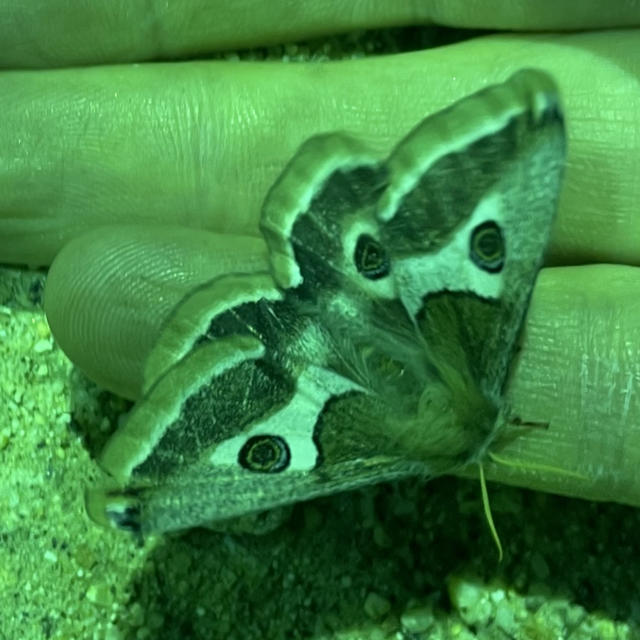White-streaked saturnia moth
Saturnia albofasciata (Johnson, 1938)
Family: Saturniidae
Subfamily: Saturniinae
Identification: Males and females differ. Females are larger than males. Upperside of female is gray-brown with distinctly darker areas at the wing bases, yellowish margins, and a well-developed eyespot on each wing. Upperside of male is orange to light brown with a weak eyespot on each wing and a partial black submarginal band on the hindwing. Both sexes have a white band on the forewing running from the eyespot to the trailing edge of the wing, although this band may be weak in the male.
Wing Span: 2 - 2 1/2 inches (5 - 6.4 cm).
Life History: Adults emerge in early afternoon, and mating takes place shortly afterwards. Females do not fly until they have mated. After dark, females lay eggs in small groups on twigs of the host plant. Eggs overwinter and hatch in April. The tightly-spun cocoon is attached to a stem of the host plant.
Flight: One flight from October-November.
Caterpillar Hosts: Buckbrush (Ceanothus cuneatus), snowbush (C. cordulatus), desert ceanothus (C. greggii), and mountain-mahogany (Cercocarpus betuloides).
Adult Food: Adults do not feed.
Habitat: Mountain chaparral communities at moderate elevations.
Range: From Lake County, California south through the Coast
Conservation: Not usually required.
NCGR: G4 - Apparently secure globally, though it might be quite rare in parts of its range, especially at the periphery.
Management Needs: None reported.
Comments: NULL
Get your BAMONA Gear!
Please donate!
We depend on donations to keep Butterflies and Moths of North America freely available. We want to express our gratitude to all who showed their support by making a contribution this year. You can donate to support this project at any time.
Advertise with us!
Do you have a product or service that you think would interest BAMONA users? If you would like to advertise on this website, contact us by email, or use the contact form and select the "Advertising" category.
Verified Sightings
Displaying 1 - 14 of 14 verified sightings

Observation date: Oct 29, 2021
Submitted by: ishaan2009
Region: Riverside County, California, United States
Verified by: ishaan2009
Verified date: Oct 30, 2021

Observation date: unknown
Submitted by: BAMONA
Region:
Verified by: BAMONA
Verified date: Sep 06, 2010
Observation date: unknown
Submitted by: legacy.reporter
Region: Riverside County, California, United States
Verified by: legacy.verifier
Verified date: Dec 31, 2004
Observation date: unknown
Submitted by: legacy.reporter
Region: El Dorado County, California, United States
Verified by: legacy.verifier
Verified date: Dec 31, 2004
Observation date: unknown
Submitted by: legacy.reporter
Region: Tulare County, California, United States
Verified by: legacy.verifier
Verified date: Dec 31, 2004
Observation date: unknown
Submitted by: legacy.reporter
Region: Lake County, California, United States
Verified by: legacy.verifier
Verified date: Dec 31, 2004
Observation date: unknown
Submitted by: legacy.reporter
Region: Baja California Norte, Mexico
Verified by: legacy.verifier
Verified date: Dec 31, 2004
Observation date: unknown
Submitted by: legacy.reporter
Region: San Bernardino County, California, United States
Verified by: legacy.verifier
Verified date: Dec 31, 2004
Observation date: unknown
Submitted by: legacy.reporter
Region: Fresno County, California, United States
Verified by: legacy.verifier
Verified date: Dec 31, 2004
Observation date: unknown
Submitted by: legacy.reporter
Region: Tuolumne County, California, United States
Verified by: legacy.verifier
Verified date: Dec 31, 2004
Observation date: unknown
Submitted by: legacy.reporter
Region: Los Angeles County, California, United States
Verified by: legacy.verifier
Verified date: Dec 31, 2004
Observation date: unknown
Submitted by: legacy.reporter
Region: San Diego County, California, United States
Verified by: legacy.verifier
Verified date: Dec 31, 2004
Observation date: unknown
Submitted by: legacy.reporter
Region: Kern County, California, United States
Verified by: legacy.verifier
Verified date: Dec 31, 2004
Observation date: unknown
Submitted by: legacy.reporter
Region: Ventura County, California, United States
Verified by: legacy.verifier
Verified date: Dec 31, 2004


